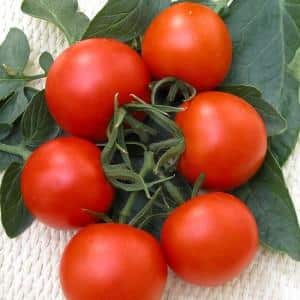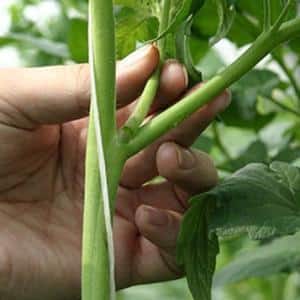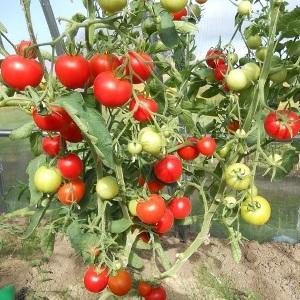Clusters of bright red fruits, like from the picture: “Verlioka” tomato - decoration of the garden bed
Classic bright red medium-sized tomatoes are simply irreplaceable in cooking. The Verlioka hybrid is an ideal option for amateur farmers. The variety does not require specific care, is productive, not susceptible to disease, and its fruits have excellent taste.
In this article we will talk about the characteristics of the variety, the features of its cultivation and care, harvesting and use of the crop.
Description of the variety
Verlioka tomatoes are a hybrid of Russian origin. It is grown mainly in greenhouses. Planting in open ground is possible only in warm regions.
A tomato bush grows 1-1.5 m high, in rare cases reaching 2 m. It is recommended to form the bush into 1 stem and carry out pinching (removing excess shoots), which increases the yield.
Fruit characteristics
 The fruits of this variety are small, weighing 80-100 g, round in shape, smooth, and deep red in color. The taste is average and has no distinctive features. Tomatoes of this variety are able to maintain a presentable appearance and pleasant aroma for a long time.
The fruits of this variety are small, weighing 80-100 g, round in shape, smooth, and deep red in color. The taste is average and has no distinctive features. Tomatoes of this variety are able to maintain a presentable appearance and pleasant aroma for a long time.
Tomato Verlioka Plus is an early ripening variety. The first harvest can be harvested 95-100 days after planting the seeds. That is, if you plant seedlings in March, you will receive fruits in June.
Distinctive features
The main distinguishing feature of this variety is the small amount of foliage.
And the peculiarity of the Verlioka Plus hybrid is its determinacy (the growth of bushes stops at a height of 150 cm).
Productivity
With proper care, 4.5-5 kg of tomatoes are harvested from the bush. The fruits ripen in clusters and cover almost all the foliage during the fruiting period.
Another plus is that tomatoes ripen almost simultaneously, even in high humidity and lack of light.
We grow seedlings
Sow seeds For seedlings it is necessary in mid-March or early April. We recommend following the step-by-step instructions below.
Seed preparation
Choose the largest ones - they have more nutrients. From such seeds, plants will grow strong and healthy.
Before planting, it is recommended to disinfect the seeds by soaking them for 15-20 minutes in 1% potassium permanganate solution. This way you will save them from possible diseases.
Soil preparation
If you plan to buy soil for seedlings, choose peat soil. If you are going to prepare the soil yourself, then mix the soil, humus and add sawdust to loosen the soil.
Choosing a container for seedlings
For the Verlioka variety, the best choice is seedling boxes. In them you can care for all the sprouts at the same time and move the container to the right place without any problems.
Sowing seedlings
Before planting, moisten the soil, make 1-2 cm depressions in it at a distance of 5 cm from each other. Place the seeds in the recesses and cover the box with film.
Place the containers in a room with a temperature of +25 degrees.
Growing and caring for seedlings
After germination, move the boxes to a well-lit room. The temperature should not be higher than +20 degrees. At night, open the window for micro-ventilation, but there should be no drafts. Until the first leaves appear, it is enough to spray the ground with water.
As soon as leaves appear on the sprouts, they need to be dumped into separate containers.When replanting, do not forget to feed the soil with liquid nutrition. Spray with moderately warm water from a spray bottle.
Planting and caring for tomatoes
Growing the Verlioka variety is not troublesome, but there are still a number of nuances. Let us introduce you to the main ones.
Landing
Prepare the soil before planting. To do this, mix peat, humus, sawdust and mullein in a ratio of 3:1:0.5:0.5, add to regular soil and loosen. If the soil is highly acidic, lime it.
Seedlings replant in mid-May - by this time the sprouts will have become stronger and there will be more foliage on them. Plant the sprouts at a distance of 40 cm from each other. Once every 5 days, irrigate the sprouts and soil with warm water. Ventilate the greenhouse.
If the weather is hot enough, then it is better to open the greenhouse all day. Young plants of this variety do not like high temperatures.
Plant care
A difficult nuance is the formation of bushes. Once the main stem has formed 3 flower clusters, carefully pinch it back so that the growing point becomes a strong shoot. Tie tall bushes to a support, otherwise they may break or be damaged.

Watering plays a special role when growing tomatoes. Watering the tomatoes every 3-7 days is sufficient, but generously (more often in hot weather, less often in cold weather). After watering, it is better to loosen the soil to ensure oxygen access to the roots.
If plant leaves droop and darken, it means they lack moisture. And if the leaves grow and turn pale, then, on the contrary, there is excess moisture.
Excessive moisture negatively affects the size and quality of the fruit - in the worst case, the bush may even die. From frequent watering, the plant loses its resistance to diseases and pests.
Do not forget to weed so that weeds do not interfere with the growth of bushes.
During the season, tomatoes need to be fed 2 times. Phosphorus fertilizer or organic fertilizer is suitable. The first time is after planting, the second time is during the fruiting period. For the ovary, prepare a solution of boric acid (1 g of boric acid per 1 liter of water) and spray the bushes with it during the flowering period.
Caring for bushes also includes pinching. Timely removal of unnecessary leaves and shoots helps increase productivity. Thanks to thinning the greenery, the plant will spend the resulting nutrients on fruit growth.
Reference. Stepchildren are shoots that appear from the axil of the leaf. New leaves grow on them, due to which the plant begins to grow in width.
The bush should grow into 1 stem, so you need to carefully break off the excess shoots. The first pinching is carried out when their length becomes approximately 5-7 cm. It is better to do this in the morning, since in the sun the wounds on the stem heal faster.
Features of cultivation and possible difficulties
The variety in question has a weak growth type, which greatly simplifies their care.
The greatest difficulty lies in pinching and timely removal of foliage.
Note. When tomato clusters begin to ripen, it is necessary to tear off all the foliage down to the point where the fruit is located. This is done gradually so that the plants calmly accept the changes. Every day it is recommended to tear off 1-2 leaves, freeing the ripening fruits.
Resistance to diseases and pests
Varieties Verlioka and Verlioka Plus are resistant to the following diseases: brown spot, fusarium, cladosporiosis, tobacco mosaic. However, as a preventive measure, we recommend loosening the soil and ventilating the greenhouse to avoid rotting of the seedlings.
If seedlings are infected with late blight, spray them with a soap solution (use laundry soap) or a specialized commercial solution.
Also, a soap solution will help get rid of pests: aphids, Colorado potato beetles, slugs. If you use industrial solutions against pests, apply to plants before flowering.
Harvesting and application
From one square meter you can harvest more than 10 kg of tomatoes. The fruits begin to ripen in mid-June, and this variety bears fruit until September.
With moderate watering, the fruit tastes sweet. Excess moisture causes the flavor to be lost and the tomatoes become watery.
Tomatoes grow small, elastic, and are well stored and transported. They are consumed fresh, in salads, and used to make pasta and lecho. These tomatoes are perfect for canning, as they do not burst when twisted.
Advantages and disadvantages of the variety
The main advantages of the variety include:
- resistance to major nightshade diseases;
- tolerance to lack of light;
- early ripening of the crop;
- good yield;
- tasty, elastic fruits that are suitable for fresh consumption and canning.
Disadvantages of the variety:
- the need for pinching and bush formation;
- sensitivity to moisture levels.
Photos of Verlioka tomatoes:

Farmers' reviews of Verlioka tomato
There are a lot of reviews from gardeners about the Verlioka tomato variety on the Internet or specialized printed publications. Let's give you some of them.
Catherine: “I tried the Verlioka variety from my summer resident friends. I don’t like tomatoes that are too sweet, so I liked the slight sourness of the tomatoes. I plant tomatoes in a glass greenhouse. The yield is good every year.Even with insufficient light, the harvest is always good. A huge plus of tomatoes is that they are disease resistant.”
Elena: “I planted this variety for the first time. I was very pleased. They bear fruit for a long time and do not get sick. The fruits are smooth and sweet.”
Antonina: “Our whole family loves tomatoes, but the Verlioka variety did not please us. Tomatoes are watery and sour. Suitable for recycling only. Caring for bushes is easy. Today there are much more tasty and stable hybrids.”
Conclusion
The tomato variety Verlioka and its hybrid Verlioka Plus are among the most popular among gardeners due to their ease of care and resistance to diseases. From a culinary point of view, the variety is also universal.
These tomatoes are consumed fresh, used in salads, hot dishes, soups and sauces. Small, strong fruits are perfect for pickling, do not crack and look beautiful in a jar.